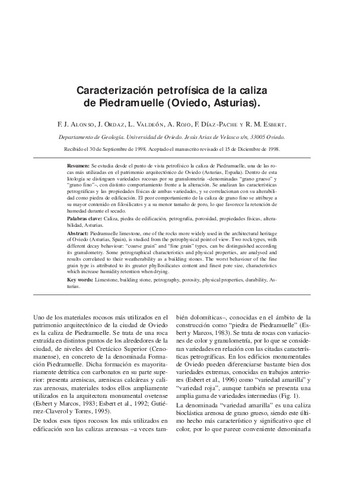Caracterización petrofísica de la caliza de Piedramuelle (Oviedo, Asturias)
Palabra(s) clave:
Caliza
Piedra de Edificación
Petrografía
Porosidad
Propiedades Físicas
Alterabilidad
Asturias
Limestone
Building Stone
Petrography
Porosity
Phisical Properties
Durability
Fecha de publicación:
Editorial:
Universidad de Oviedo, Departamento de Geología
Citación:
Descripción física:
Resumen:
Se estudia desde el punto de vista petmfisico la caliza de Piedramuelle, una de las rocas más utilizadas en el patrimonio arquitectónico de Oviedo (Asturias,España). Dentro de esta litologia se distinguen variedades rocosas por su granulometria -denominadas "grano grueso" y "grano fino-. con distinto comportamiento frente a la alteración. Se analizan las caracteristicas petrográficas y las propiedades físicas de ambas variedades, y se correlacionan con su alterabilidad como piedra de edificación. El peor comportamiento de la caliza de grano fino se atribuye a su mayor contenido en filosilicatos y a su menor tamaño de poro, lo que favorece la retención de humedad durante el secado.
Se estudia desde el punto de vista petmfisico la caliza de Piedramuelle, una de las rocas más utilizadas en el patrimonio arquitectónico de Oviedo (Asturias,España). Dentro de esta litologia se distinguen variedades rocosas por su granulometria -denominadas "grano grueso" y "grano fino-. con distinto comportamiento frente a la alteración. Se analizan las caracteristicas petrográficas y las propiedades físicas de ambas variedades, y se correlacionan con su alterabilidad como piedra de edificación. El peor comportamiento de la caliza de grano fino se atribuye a su mayor contenido en filosilicatos y a su menor tamaño de poro, lo que favorece la retención de humedad durante el secado.
Piedramuelle limestone, one of the rocks more widely, used in the architectural heritage of Oviedo (Asturias, Spain), is studied from the petrophysical point of view. Two rock types, with different decay behaviour: "coarse grain" and '"fine grain" types, can be distinguished according its granulometry. Some petrographical characteristics and physical properties, are analysed and results correlated to their weatherability as a building stones. The worst behaviour of the fine grain type is attributed to its greater phyllosilicates content and finest pore size, characteristics which increae humidity retention when drying.
Piedramuelle limestone, one of the rocks more widely, used in the architectural heritage of Oviedo (Asturias, Spain), is studied from the petrophysical point of view. Two rock types, with different decay behaviour: "coarse grain" and '"fine grain" types, can be distinguished according its granulometry. Some petrographical characteristics and physical properties, are analysed and results correlated to their weatherability as a building stones. The worst behaviour of the fine grain type is attributed to its greater phyllosilicates content and finest pore size, characteristics which increae humidity retention when drying.
Ficheros en el ítem




